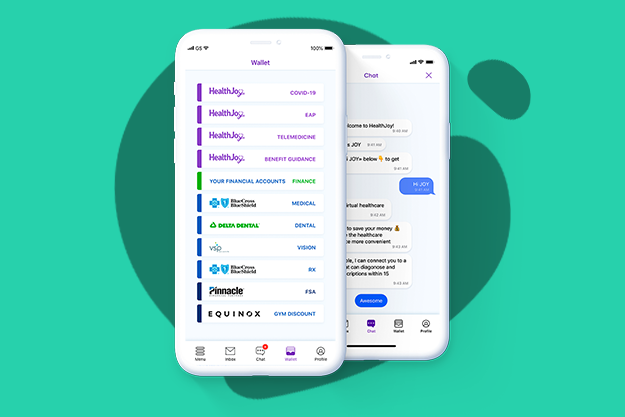How to Simplify Benefits Communication for Open Enrollment
Benefits communication is notoriously tricky. Lunch and learns? Employees resent taking time out of a busy day. Long emails? They’re all too easy to...
Connected Navigation Platform
Guiding to high-value care
Behavioral Health
Foster a mentally healthy workplace
EAP
Supporting holistic wellbeing
Virtual MSK Care
Reimagining musculoskeletal care
Virtual Primary Care
Powered by smart navigation
Surgery Centers of Excellence
Best-in-class surgical outcomes
Virtual Urgent Care
Immediate care, any hour of the day
Chronic Care
A new approach to chronic care
Integrations
Flexible to any strategy
5 min read
 Rose De Leon
:
October 13, 2021
Rose De Leon
:
October 13, 2021

There’s a lot to consider during open enrollment, and it can be easy to focus on the new benefits you’re rolling out to employees. But taking time to focus on the first steps during OE can set your benefit up for success. While you’re gearing up for enrollment, consider how balancing the following three factors can support benefits program success.
While there are myriad ways to measure progress, one way to set and measure goals is through key performance indicators (KPIs). KPIs are measurable values that determine how effectively an individual, team, or organization achieves a business objective. They can employers know whether they’re spending time, budget, and talent on the right strategies, tasks, and tools to achieve their goals. Some examples of employer KPI’s might be:
Decrease employee turnover by 10% in 2022
Increase revenue 15% by Q3 2022
When it comes to KPIs, there are two types to know: lagging and leading.
Lagging KPIs measure the current state of business and focus on the outcome of an event.
This type of indicator answers questions like:
How many people participated in the event?
How did people react to an event? (i.e., product release, webinar, etc.)
How much product sold?
Unlike the lagging type, leading KPIs are predictive in nature. They provide valuable insight via specific benchmarks, that, if met, will “lead” to meeting HR’s objectives.
This type of indicator answers questions like:
How can I improve an existing process for maximum efficiency?
What steps should HR take during OE to increase employee engagement?
Working with your benefits vendors’ customer support team is crucial to creating a clear vision of what you want to accomplish. They can identify the data your company is already tracking (or needs to track) to inform and set realistic targets and timelines for your HR team’s goals.
After you’ve decided on which KPIs to implement, you’ll need to establish a baseline metric for comparison purposes. Take healthcare cost trends as an example. To understand health spending year-over-year, you could look at the national average and industry peers. If you discover that your costs are higher than the national average, then it’s worth finding out why.
Monitoring KPI status ensures the information you’re tracking remains useful to your HR department, communicates progress to company management, and gives a sense of what type of tools you’ll need to pull information.
It’s worth noting that KPIs are rarely static. As your employee population grows, people’s needs will change, which means KPIs will likely require occasional revisiting and adjusting. Be sure to ask your customer support team for regular check-ins and progress reports, if you don’t already have access to a central hub like an HR Dashboard.
“What gets measured gets managed.” – Peter Drucker
Goals — no matter how minor — are powerful. They set the tone and provide direction and motivation to help your organization achieve its business objectives and fulfill the needs of your stakeholders. However, deciding which goals to measure and how they’re tied to success can get complicated, especially within the context of employee benefits, where you’ll have to gauge how workers use, understand, and use their benefits. Again, your vendors’ customer success team should act as a guide and provide the data insights you need to gauge program success.
For example, member utilization rates allow our customer support team to see how employees are engaging with their benefits. Whether it’s finding a provider or accessing insurance cards, tracking the number of unique actions can clue you into the effectiveness of various programs, like gym memberships or wellness solutions. It also provides a snapshot of which benefits employees find valuable, which offerings need re-evaluation, and the state of the workforce’s overall health.
Benefit programs account for more than 30% of total headcount expenses, and employers will want to get the most out of their investment. Without data from your customer success team, it can be difficult to determine ROI, manage plan design, and prove your benefits’ value to leadership.
For leadership to understand your strategy, be transparent when discussing what you’re measuring and why. A lack of consensus on where to invest, what communication strategy to implement, or what benefits plan makes the most sense creates a logjam that stalls progress.
Your leadership team want to know they’re making sound business decisions. Being aware of your intentions can help managers and stakeholders understand which metrics contribute to employees’ success, “buy in” to your goals, and provide feedback when necessary.
When communicating your objectives, it’s important to narrow your focus into a few key initiatives based on your budget and employee impact. You don’t want to overextend your team, then find yourself with a long list of objectives and zero progress toward any of it. We all know the struggle of wanting to accomplish many things at once. Success comes from the ability to zero in on areas we can realistically improve and consistently track progress.
Make sure leadership remains aware of the timelines you’ve set for your KPIs. While raw data can provide an objective view of what’s occurring in real time, it doesn’t show the whole picture. Take note of which KPIs will need more time to allow for data collection, and what objectives will be affected as a result. That way, leadership isn’t surprised by slow reporting or lack of information.
As you track your employee benefits progress, be sure to share positive stories with the leadership team. For example, let’s say an employee shares that a new healthcare navigation benefit helped them quickly find an in-network provider after a move to a new neighborhood. Capture those stories in writing and be sure to share them with key stakeholders and the larger organization. Stories of incremental success create a compelling narrative about how their investments favorably impact employee productivity, retention rates, and engagement. They can improve the perception of your new benefits’ value AND might encourage reluctant employees to try it out for themselves.
Benefits success starts, of course, with open enrollment. Your OE communications have a lot to accomplish in a short amount of time: they must educate employees, get them to select benefits, and give them information that will help them and their families next year (see our post Driving Family Benefits Engagement Beyond OE for more). They can also lay the groundwork for benefits success.
When promoting your new benefit during this time, focus your efforts on employees’ preferred communication methods first. In our 20201 Employee Benefits Insights Report, 28% of employees revealed they want to view their benefits information through an app, while 23% preferred email. We’ve found that by aligning benefits communication with employees’ preferences, HR teams bridge knowledge gaps that extend beyond the open enrollment period.
As you gear up for your busiest season of the year, using open enrollment templates, tools, and guides is a smart way to simplify your life and make sure you’re communicating early, often, and effectively. No matter your goals, your employee benefits communications should cover the basics:
when to enroll in your employee benefits plan
how enrollment works (step-by-step)
how to enroll spouses or dependents (step-by-step)
any important changes to your plan or benefits offerings that employees should be aware of this year
Inside our Ultimate Open Enrollment & Benefits Communication Kit, you’ll find four assets designed to help keep you on track, refine messaging, punch-up benefits presentations, and craft emails with ease. They remove the guesswork from employee benefits communications — allowing your HR team to focus their time and energy on other important tasks.
Educating employees about their benefits is an ongoing process. To keep employees engaged with their benefits, HR teams will need to reach out year-round. Part of that effort, however, will require tracking the success of your benefits communications. From employee surveys to email open rates and intranet analytics, knowing what is or isn’t working will allow you to make the necessary adjustments to meet the needs of your employees.
Since benefits are one of employers’ top expenses, their “success” — however you agree to define it — matters. Ensuring that success requires a solid strategy. Metrics provide valuable insight that can help your HR team make informed decisions, refine messaging, and create achievable goals to help your benefits program succeed well beyond OE.

Benefits communication is notoriously tricky. Lunch and learns? Employees resent taking time out of a busy day. Long emails? They’re all too easy to...

Open enrollment packs many communication challenges into a short window of time. Any HR professional can tell you it’s made extra difficult because...

1 min read
Building a genuinely satisfying employee benefits package is at the top of every HR professional’s mind, but getting there is harder than ever...